
views
- It takes about 1 hour to replace a light switch even if you don’t have a lot of experience doing electrical repairs.
- You’ll need a screwdriver and needlenose pliers to replace your switch. You may also need wire strippers if the wiring is damaged.
- Turn off the power to your light switch before you start any repairs. Test the switch with a voltage tester to make sure the switch has no power.
Turning off Power and Testing the Switch
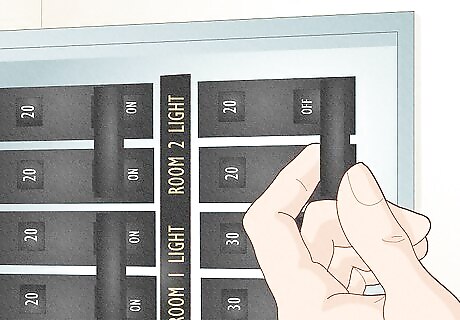
Switch off power to the light switch at the breaker box. You can usually find the metal breaker box in your basement, garage, kitchen, or hallway. Check the breaker labels to see which one controls the room with the switch that you’re replacing and flip it to the “OFF” position to completely cut off power to the circuit. If you aren’t sure which breaker controls the switch you want to replace, then turn off the main power switch in the breaker box to cut off all the power in your home. Leaving the power on while you work on the light switch puts you at risk for electrocution, so always turn off the power before you start working.
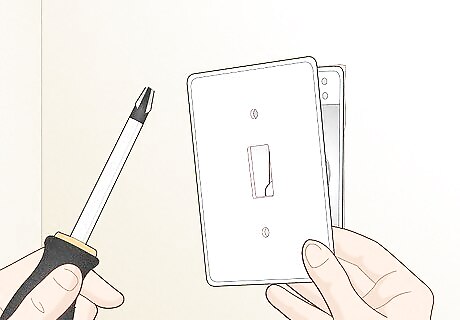
Remove the switch plate. The switch plate is the plastic cover over the switch and electrical box that hides the wires. Turn the screws on the switch plate counterclockwise with a screwdriver to loosen them. Then just pull the switch plate straight off of the switch. If the switch plate is stuck to paint on the wall, run a utility knife around the edges of the switch plate to cut through the paint.

Check the switch with a voltage tester to ensure it has no power. Use a voltage tester by touching the tip next to each of the screw terminals on the sides of the switch. If the wire still has power running through it, the tester will light up or beep. If the power is completely turned off, then the tester won’t react at all. If there’s still power running to the switch, then it’s connected to another circuit breaker than the one you turned off.
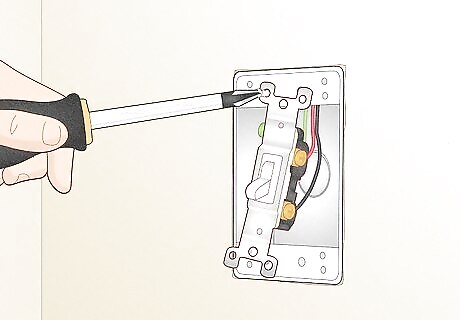
Unscrew the switch’s mounting screws to remove it. Use a screwdriver to turn the mounting screws on the top and bottom of the switch counterclockwise. Once the screws are completely loose, gently pull the switch out of the electrical box to expose the wires.
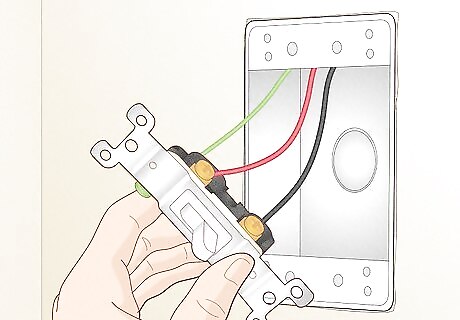
Inspect the wiring and connections to determine the type of switch. Look at the colors of the terminal screws on the sides of the switch and pay attention to the color of the wire attached to each one. If you see 2 gold terminal screws and 1 green ground screw, then you’re changing a single-pole switch. If there are 1 or 2 black screws, 2 brass terminal screws, and 1 green ground screw, then you're replacing a 3- or 4-way switch. A single-pole switch is the most common type, and it will be the only switch that controls a light fixture. It will usually have “On” and “Off” printed on the switch. 3- or 4-way switches are usually used in large rooms or hallways so multiple switches control the same light fixture. These switches usually don’t have any words printed on them.
Replacing a Single-Pole Light Switch

Unscrew the wires from the terminal screws. Look for the 3 terminal screws that have the wires connected to them on the sides of the switch. Use your screwdriver to turn each of the screws counterclockwise to loosen them. When the terminal screws are loose, gently unhook the ends of the wires from them. If the wires are in a slot on the back of the switch, push the end of a small screwdriver in the slot to disconnect them. Single-pole switches have 3 wires connecting to them: a black hot wire leading back to the power source, a black or red hot wire leading to the fixture, and a green or bare copper ground wire. Take a picture of how the wires are attached before you disconnect them to use as a reference when you connect the new switch.
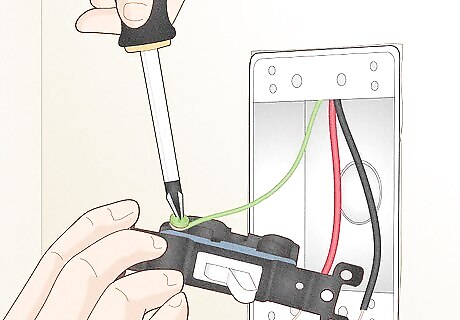
Connect the ground wire to the green grounding screw on the new switch. Locate the ground wire that has either green insulation or bare copper. Bend the exposed end of the wire into a hook with a pair of needlenose pliers. Hook the wire underneath the green screw on the bottom of your new single-pole switch. Turn the screw clockwise to tighten it until the wire is secure. If the exposed end of the wire looks damaged or dirty, cut it off with wire strippers. Strip the wire so there’s ⁄2 inch (1.3 cm) of wiring at the end. Push-in connections where the wires fit into slots on the back of the switch are less secure than mounting the wires to the screws.
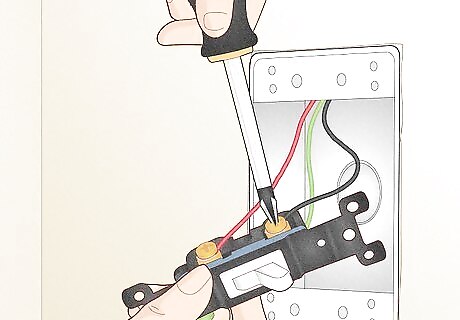
Hook the hot wires to the gold terminal screws. One hot wire will be black, but the other may be red, black, or any other color besides green. Use your pliers to bend a small hook on the exposed end of each of the wire. Loop 1 wire underneath each of the gold terminal screws, usually on the top and bottom of your switch. Turn the screws clockwise with your screwdriver to secure the wires. You can connect either wire to each of the screws. Your switch will still work no matter which way it’s wired.
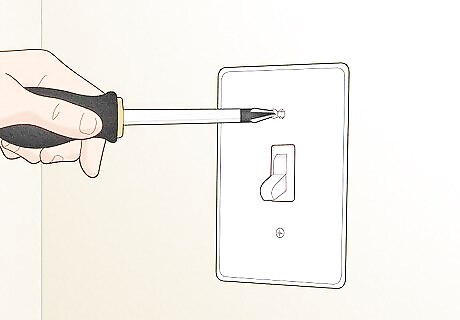
Screw the switch and switch plate back on the electrical box. Gently push the wires back into the electrical box and position your light switch so the “On” position is on top. Tighten the mounting screws by turning them clockwise so the switch is secured. Then, fit the switch plate over the switch and screw it back in.
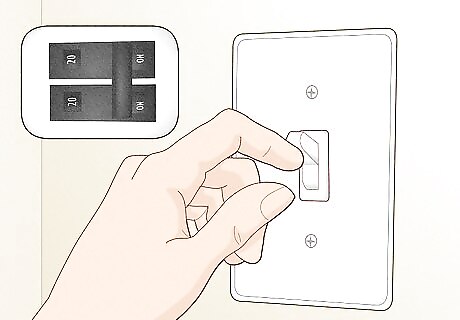
Turn on the power to test the switch. Make sure your newly installed switch is in the “Off” position to start. Go back to your breaker box and flip the breaker to the “On” position so your switch has power again. Try flipping the switch on to make sure it turns your light fixture on. If the light turns on, then you’re finished! If the switch still doesn’t work, turn off the power to check that you attached the wires securely and to the right terminal screws. If you still have trouble, you may need to contact an electrician.
Changing a 3-Way or 4-Way Light Switch
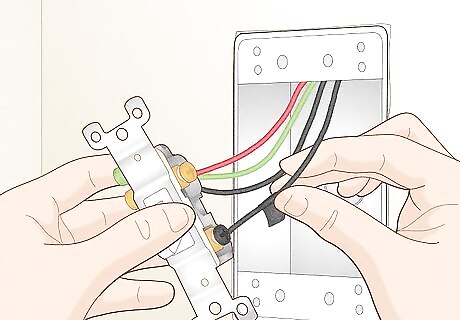
Mark the wires attached to the black screws with electrical tape. The common terminal screws on the sides of a switch connect the power source to the fixture and are usually a darker color than the other screws. Look for the wires that attach to the 1 black screw on a 3-way switch or the 2 black screws on a 4-way switch. Rip off a piece of electrical tape and wrap it around each of the wires that are connected to the screws. That way, you remember which wires are the hot wires that carry the current. A 3-way switch has 4 wires: 1 black hot wire that’s connected to the power source or the fixture, 2 black or red traveler wires running between the switches, and 1 green or bare copper ground wire. A 4-way switch has 5 wires: 2 black or red hot wires connecting to the power source or fixture, 2 black or red traveler wires between the switches, and 1 green or bare ground wire.
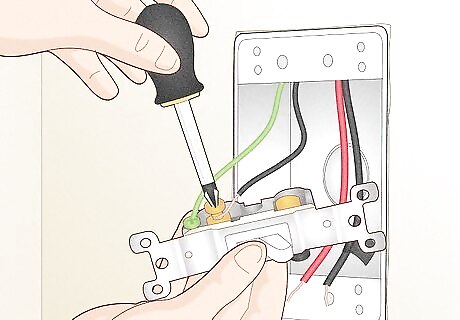
Disconnect the wires from the switch. Turn all of the terminal screws counterclockwise to loosen them from the switch. Unhook the wires if they’re mounted directly to the screws, or pull them out of the slots on the back. Take a picture of the wires before you disconnect them so you can remember how to correctly reinstall them on the new switch.
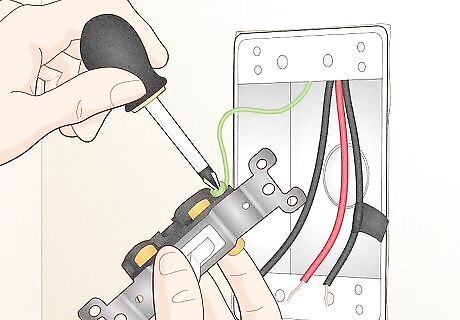
Attach the ground wire to the green screw on the new switch. The green ground screw is usually on the bottom of a new 3-way or 4-way switch. Bend the end of the bare copper or green wire into a hook, and loop it clockwise behind the ground screw. Tighten the screw with your screwdriver until the wire is completely secure. If the end of the wire is damaged, snip it off with a pair of wire strippers. Secure the strippers ⁄2 inch (1.3 cm) from the end of the wire. Squeeze the handles tight and pull the strippers toward the end of the wire to remove the insulation.
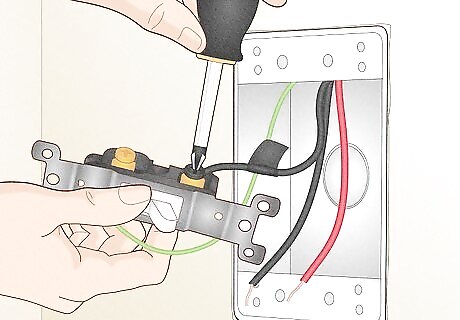
Attach the labeled wires to the black common screws. The wires you marked with tape are usually black or red, but they may differ in your home. Bend a hook into the end of the marked wires. Loop one hot wire onto each of the black common screws. Then, turn the screws clockwise to completely secure them. If you’re wiring a 4-way switch, it doesn’t matter which of the marked wires connects to each of the black common screws.
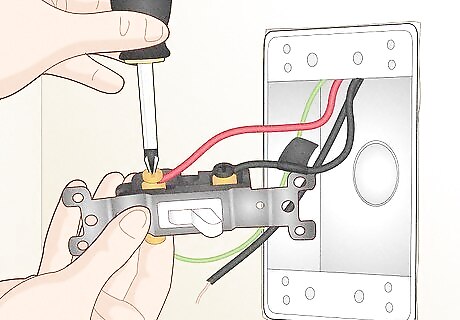
Connect the traveler wires to the brass terminal screws. The traveler wires are usually red and black, but they may be any color besides green. Bend hooks in the exposed ends of the traveler wires, and loop them clockwise onto the brass terminal screws on the sides of your switch. Just tighten the screws with your screwdriver to secure them in place. Check the other switches that control the light on the circuit to determine the position of each traveler wire. If a red wire connects to the top brass screw, then connect the red wire to the top screw on the new switch.
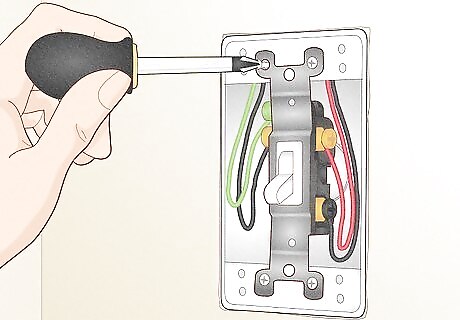
Screw the switch and switch plate back onto the electrical box. Gently push in all of the wires and hold the switch against the electrical box. Turn the mounting screws clockwise until the switch is held tightly on the wall. Then, secure the switch plate over the new switch and screw it in.

Reconnect power and test your switch. Turn the breaker for the circuit back to the “On” position so the switch has power running through it. Start by testing the switch that you just installed to make sure it controls the light. Then, check the other switches connected to the fixture to make sure they’re all connecting properly. If the switch still doesn’t work or another switch on the circuit stopped working, then you may have connected the wires incorrectly. Turn off power and double-check the connections.
Converting to a Dimmer Switch
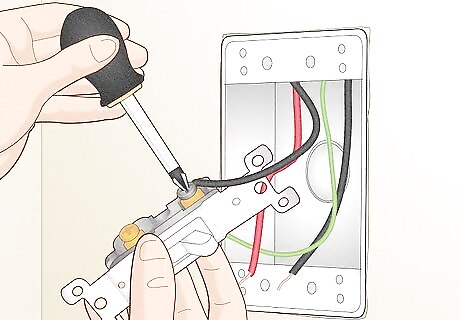
Unscrew the wires from the switch’s terminal screws. Locate the 3 or 4 terminal screws on the side of the switch. Use your screwdriver to turn each of the terminal screws counterclockwise until they’re loose. Unhook each of the wires from the screws and bend them so they’re out of the way. If you’re converting a single-pole switch to a dimmer, then you’ll have 3 wires: 1 black hot wire leading back to the power source, 1 black or red hot wire leading to the light fixture, and 1 green or bare ground wire. If you’re converting a 3-way switch to a dimmer, you’ll see 4 wires: 1 black hot wire connecting to the power source or fixture, 2 black or red traveler wires that run between the switches, and 1 green or bare ground wire. Mark the hot wire with a piece of electrical tape so you don’t forget. Take a picture of the wiring so you can easily remember how it connected to the switch as a reference.
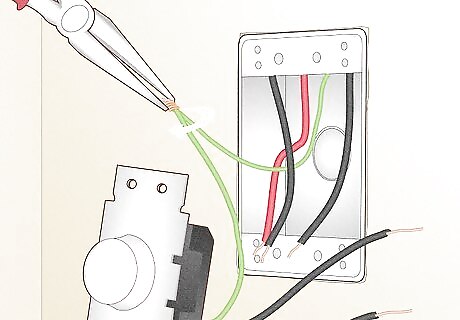
Twist together the ground wire to the green wire on the new dimmer switch. Get a new single-pole or 3-way dimmer switch depending on the switch you’re replacing. Take the end of the green wire attached to the dimmer and hold it next to the end of the green or bare wire in the electrical box. Use needlenose pliers to twist the ends of the wire together before screwing a wire cap onto the end. If your dimmer switch has screws instead of wires, loop the green or bare wire around the green screw on the switch and tighten it with a screwdriver.
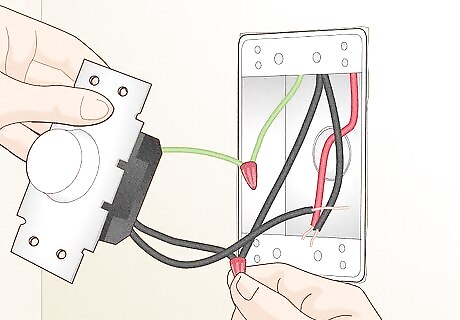
Connect the hot wires to the black wires on a single-pole dimmer switch. On a single-pole dimmer, it doesn’t matter which wire in the electrical box connects to each hot wire on the switch. Twist the ends of the wires together with your pliers and secure a wire cap over the exposed ends. If the dimmer switch has terminal screws, then loop the wires around them and tighten them with a screwdriver.
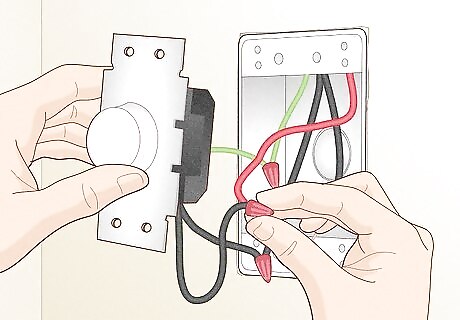
Secure common and traveler wires to the matching screws on a 3-way switch. Make a hook on the end of the taped wire with your pliers. Loop the hook around the black common terminal screw on the side of the 3-way dimmer switch. Hook 1 traveler wire that is red or black onto each of the brass terminal screws. Tighten all the screws with your screwdriver so the wires won’t pull out. If any of the ends look damaged or dirty, cut them off with wire strippers. Remove ⁄2 inch (1.3 cm) of insulation from the end of the wire with the strippers so you have a newly exposed end.
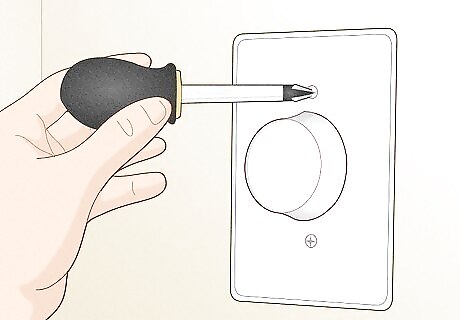
Reattach the switch and switch plate to the electrical box. Gently push the wires back into the electrical box and orient the dimmer switch so the “On” position is at the top. Secure the mounting screws back onto the switch and electrical box before screwing on the switch plate.

Turn power onto your switch and test that it works. Flip the breaker switch back to the “On” position so your switch has power. Try adjusting the switch to make sure it controls the light properly. If the switch doesn’t work, turn off the breaker and check the wire connections to make sure they’re secure and in the right place. If you still can’t find the issue, contact an electrician.




















Comments
0 comment